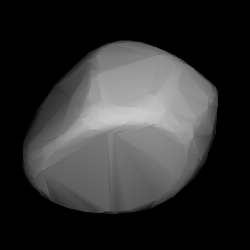Top Qs
Timeline
Chat
Perspective
3015 Candy
Main-belt asteroid From Wikipedia, the free encyclopedia
Remove ads
3015 Candy (prov. designation: 1980 VN) is a background asteroid from the outer regions of the asteroid belt, approximately 25 kilometers (16 miles) in diameter. It was discovered on 9 November 1980, by British-American astronomer Edward Bowell at Anderson Mesa Station in Flagstaff, Arizona.[13] The asteroid was named after British astronomer Michael P. Candy.[2]
Remove ads
Orbit and classification
Candy is a background asteroid that does not belong to any known asteroid family. It orbits the Sun in the outer main-belt at a distance of 2.8–4.0 AU once every 6 years and 3 months (2,276 days). Its orbit has an eccentricity of 0.17 and an inclination of 17° with respect to the ecliptic.[1] The body's observation arc begins with a precovery taken at Goethe Link Observatory in May 1965, more than 15 years prior to its official discovery observation at Anderson Mesa.[13]
Remove ads
Naming
This minor planet was named after Michael P. Candy (1928–1994) a British astronomer and discoverer of minor planets and comets, who was a director of the Royal Greenwich Observatory and Perth Observatory.[2] As a long-time astrometrist and orbit computer, he discovered comet C/1960 Y1 (Candy) at Greenwich, as well as the minor planet 3898 Curlewis, 3893 DeLaeter and 3894 Williamcooke. He was also president of IAU's Commission VI.[2] The official naming citation was published by the Minor Planet Center on 22 June 1986 (M.P.C. 10845).[14]
Remove ads
Physical characteristics
Summarize
Perspective
Candy is an assumed carbonaceous C-type asteroid.[3]
Lightcurves
Several rotational lightcurves of Candy were obtained from photometric observations by astronomer Maurice Clark. Lightcurve analysis gave a well-defined rotation period between 4.6249 and 4.62516 hours with a brightness variation between 0.50 and 1.05 magnitude (U=3/3/3/3/3). (A high brightness amplitude typically indicates that a body has a non-spheroidal shape.)[6][7][8][9][10]
A 2016-published lightcurve, using modeled photometric data from the Lowell Photometric Database (LPD), gave a concurring period of 4.625223 hours (U=2), as well as two spin axis of (142.0°, −26.0°) and (346.0°, −70.0°) in ecliptic coordinates (λ, β).[11] Clark's spin modeling also suggests that Candy has a retrograde rotation, and a spin axis of (306.0°, 43.0.0°), that is nearly aligned with the body's shortest axis.[10]
Diameter and albedo
According to the survey carried out by the NEOWISE mission of NASA's Wide-field Infrared Survey Explorer, Candy measures 24.517 kilometers in diameter and its surface has an albedo of 0.1067,[4][5] while the Collaborative Asteroid Lightcurve Link assumes a standard albedo for carbonaceous of 0.057, and calculates a diameter of 33.54 kilometers based on an absolute magnitude of 11.1.[3]
References
External links
Wikiwand - on
Seamless Wikipedia browsing. On steroids.
Remove ads

